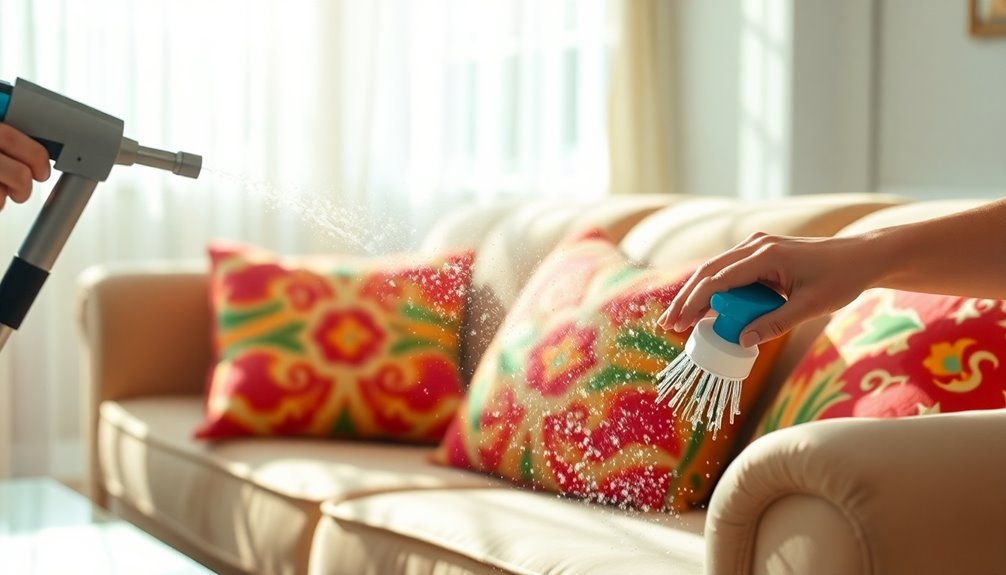To wash your sofa cushions, start by checking the care label for specific instructions. Remove loose debris and vacuum with an upholstery attachment. For removable covers, machine wash them in cold water on a gentle cycle using a mild detergent. If you can’t remove the covers, spot clean stains with a damp cloth and mild detergent. A steam cleaner is great for deep cleaning non-removable cushions. After washing, air dry or tumble dry on low heat, then fluff to restore shape. Keep your sofa looking fresh, and discover more tips for maintaining your cushions efficiently. For daily maintenance, regularly fluff and rotate the cushions to prevent uneven wear. To keep them smelling fresh, sprinkle baking soda on the cushions, let it sit for a few hours, then vacuum it up. For stubborn odors, lightly spray a mixture of water and vinegar and let it air dry. These sofa cleaning tips can help extend the life of your cushions and keep your sofa looking and smelling its best.
Key Takeaways
- Check care labels for specific washing instructions and whether cushions are machine washable or require spot cleaning.
- Remove loose debris and vacuum cushions thoroughly before washing to ensure effective cleaning.
- For removable cushions, machine wash in cold water on a gentle cycle using mild detergent; air dry to prevent shrinkage.
- For non-removable cushions, use a steam cleaner or damp cloth with mild detergent for spot cleaning, avoiding soaking.
- Regularly vacuum and schedule professional cleaning every 1-2 years to maintain cleanliness and fabric integrity.
Introduction

Keeping your sofa cushions clean starts with a regular weekly vacuuming schedule to remove dust and debris. Depending on whether your cushions are fabric, leather, or microfiber, you'll need different cleaning methods, especially when tackling tough stains like wine or coffee. By understanding the right approach for your specific material, you can maintain the look and longevity of your cushions.
Weekly Vacuuming Schedule
A clean sofa not only enhances your living space but also promotes a healthier environment. To achieve this, establish a weekly vacuuming schedule for your sofa cushions. By vacuuming regularly, you effectively remove dust, pet hair, and allergens that can accumulate over time.
When you vacuum, use an upholstery brush attachment to ensure thorough cleaning, and always follow the direction of the fabric fibers. Don't forget to lift and vacuum the undersides of removable cushions, as debris often collects there, contributing to dirt buildup. This simple step is crucial for maintaining a clean sofa.
Additionally, employ a crevice tool to reach seams and tight spaces where dirt can hide. By ensuring no area is overlooked during your cleaning routine, you can maintain the freshness of your sofa cushions. Regular vacuuming not only keeps your cushions looking clean but also extends their lifespan by preventing dirt buildup and reducing the likelihood of permanent stains. Incorporating this maintenance practice into your weekly routine will help you enjoy a clean and inviting living space for you and your guests.
Fabric, Leather, or Microfiber
When you choose sofa cushions, the material matters significantly for both maintenance and longevity. Fabric sofa cushions can vary widely in care requirements. Always check the care label; if it has a "W" code, they're likely machine washable. Otherwise, you may need to rely on spot cleaning or professional cleaning services for non-removable cushion covers.
Leather cushions require a different approach. Use a damp cloth to wipe away dust and stains, then apply a leather conditioner to keep the material supple. Just remember, excessive moisture can damage leather, so avoid soaking it.
Microfiber cushions are quite user-friendly. You can easily spot clean them with a gentle cleaning solution made from water and mild detergent. For tougher stains, rubbing alcohol works wonders. Before applying any cleaning solution on fabric cushions, always perform a colorfastness test to prevent any unwanted discoloration.
Ultimately, understanding the specific needs of your sofa cushion material will help you maintain its appearance and extend its life, ensuring your sofa remains a comfortable and stylish centerpiece in your home.
Tackling Wine and Coffee Stains
Sofa cushions can easily fall victim to spills, especially from wine and coffee, which can leave unsightly stains if not addressed promptly. When you notice a wine stain, act quickly. Blot the area immediately with a clean cloth to absorb excess liquid—don't rub, as this can spread the stain further. For coffee stains, mix one cup of white vinegar, one cup of water, and two teaspoons of dish soap to create a cleaning solution. Apply it with a soft cloth and gently blot until the stain lifts.
Before using any cleaning solution, always test it on an inconspicuous area of the fabric to check for colorfastness. If the stain proves stubborn, consider an enzyme-based cleaner designed to break down organic materials from wine and coffee. After treating the stain, rinse the area with clean water to eliminate any residue from the cleaning solution, then blot dry with a towel. By following these steps, you'll keep your sofa cushions looking fresh and clean, free from the evidence of those accidental spills.
Sofa Care for Kids

When you've got kids around, choosing the right fabric for your sofa is crucial. Consider pet-resistant options and patterned fabric throws to hide stains and wear. Plus, using fabric protectants can make clean-ups a breeze, so you can focus more on fun and less on mess.
Pet-Resistant Fabric Selection
For homes filled with kids and pets, choosing the right sofa fabric is crucial for maintaining both comfort and cleanliness. Start by selecting durable fabrics like microfiber or tightly woven materials, which resist stains and wear. Look for pet-resistant fabrics treated with stain-repellent finishes to make clean-up a breeze after spills or accidents.
Opt for fabrics labeled as "easy clean" or "water-resistant" to offer extra protection against liquids, ensuring your sofa can withstand the chaos of daily life. Dark or patterned fabrics can help conceal pet hair and minor stains, reducing the need for frequent deep cleaning.
Removable covers can also be a game-changer, allowing you to toss them in the wash whenever needed. When making your choice, check the fabric's care codes; those marked with "W" or "WS" allow for water-based cleaning methods, simplifying maintenance. By prioritizing these features, you'll create a comfortable and stylish space while keeping your sofa looking its best despite the inevitable stains on your couch. Additionally, ensure that the fabric you choose meets fire safety standards to provide an extra layer of protection in your home.
Opt for Patterned Fabric Throws
Patterned fabric throws are a smart addition to any family living space, especially when kids are involved. These throws effectively camouflage stains and spills, making them a practical choice for households with little ones. Opt for throws made from durable materials like cotton or polyester, as they're not only machine-washable but also designed for easy maintenance.
When selecting throws, go for bold patterns or darker colors. They're less likely to show dirt and wear compared to solid colors, keeping your cushions looking fresh longer. Plus, if a spill does happen, you can simply toss the throw in the wash, making it a cost-effective solution to refresh your couch's look while protecting the underlying fabric.
Regularly rotating and cleaning these patterned fabric throws helps maintain a clean and inviting living space. In a family-friendly environment, this practice ensures that your sofa stays in good condition, accommodating playtime without sacrificing style. With a bit of care, these throws can enhance your home's aesthetic while making your life easier. Additionally, using various payment options such as mobile payment services can make shopping for such accessories more convenient. So, invest in patterned fabric throws and enjoy a stylish yet practical living area that's ready for anything your kids throw at it!
Using Fabric Protectants
Using fabric protectants can be a game changer for maintaining your sofa cushions, especially in homes with kids. These products create a barrier that helps repel liquids and stains, making it easier to clean up spills quickly before they set in. Many fabric protectants are water-based and compatible with various upholstery materials, ensuring safety for both synthetic and natural fabrics.
After cleaning your cushions, applying a fabric protectant helps maintain their appearance and longevity by preventing dirt accumulation and reducing the frequency of deep cleaning needed. It's crucial to regularly reapply fabric protectants, as recommended by the manufacturer, particularly in households with kids or pets prone to messes.
Before applying any protectant, always test it on a small, inconspicuous area of the cushion first. This step ensures it won't alter the color or texture of your upholstery. For removable slipcovers, you can also treat them separately for added protection. With proper use of fabric protectants, you'll be set for long-term maintenance, keeping your sofa cushions looking fresh and clean for years to come.
Upholstery Stitching Reinforcement

When you care for your sofa cushions, don't overlook the importance of upholstery stitching reinforcement. By ensuring the integrity of the cushion frame and using techniques like double stitching, you can enhance durability and prevent wear. This attention to detail not only revitalizes your sofa's feel but also sets the stage for effective leather repair when needed.
Cushion Frame Integrity
Strong upholstery stitching reinforcement is essential for maintaining the integrity of your sofa cushions. When you invest in a quality couch, you want to ensure that the cushions maintain their structural integrity over time. High-quality stitching, like double-stitched seams, provides the durability needed to prevent fraying or unraveling. The choice of thread material also matters; polyester or nylon threads resist wear and tear much better than cotton.
Regular inspection of your upholstery stitching can help you spot any signs of weakness early on. This proactive approach allows you to make timely repairs and prolong the life of your cushions. Reinforced stitching enhances not only the visual appeal of your cushions but also their overall comfort and performance. It ensures that the fill securely stays in place, maintaining the shape and support you expect from your couch.
Always check the manufacturer's tag for specific care instructions and stitching details, as this information can guide you in maintaining the quality of your sofa. By prioritizing upholstery stitching reinforcement, you'll enjoy a more durable and comfortable couch for years to come.
Leather Repair Techniques
Repairing leather upholstery effectively requires the right techniques to ensure durability and a seamless finish. Start by cleaning the area with a leather cleaner for proper dirt removal, as any residue can hinder your repair efforts. Once it's clean, assess any damage; if there are tears, use a leather adhesive to bond edges before stitching.
For upholstery stitching reinforcement, grab a heavy-duty needle and thread specifically designed for leather. It's crucial to match the thread color to the leather, ensuring a consistent look after your repairs. The saddle stitch technique is highly recommended here; it uses two needles, creating a secure seam that's stronger than a single-thread stitch.
As you sew, make sure your stitches are evenly spaced and tight, which will add to the durability of the repair. This method not only reinforces the stitching but also enhances the overall integrity of the leather upholstery. By following these steps, you'll achieve a professional-looking repair that will stand the test of time. Remember, the right techniques make all the difference in leather repair!
Revitalizing Your Sofa's Feel
Revitalizing your sofa's feel starts with reinforcing upholstery stitching, which can significantly enhance both comfort and durability. By preventing seam fraying and unraveling, you'll extend the life of your sofa cushions. Begin by regularly inspecting the seams for signs of stress or loose threads. If you notice any issues, act promptly to reinforce those seams using a strong polyester thread, known for its durability and resistance to wear and tear.
Consider using a sewing machine for this task, as it provides consistent tension and strength compared to hand stitching. After reinforcing the seams, applying a fabric sealant can further protect these areas from moisture and dirt, ensuring they remain strong even during the cleaning process. Additionally, integrating smart home devices can help monitor the cleaning environment and maintain optimal conditions for your upholstery.
When washing your removable slipcovers, be sure to follow the manufacturer's instructions. Use water and a gentle detergent to keep them smelling fresh while avoiding harsh chemicals that could weaken the upholstery stitching. Regular cleaning, combined with these reinforcement techniques, will not only keep your sofa looking great but also enhance its overall feel, making your living space inviting and comfortable for years to come.
Cushion Cover Fabric Choices

Choosing the right fabric for your sofa cushions can make a significant difference in both comfort and maintenance. When selecting cushion covers, consider fabric types carefully. Natural fabrics like cotton, linen, and silk often provide a luxurious feel but require gentle cleaning methods to avoid damage. Always check the care label for cleaning codes, like "W" for water-safe, which indicates you can use water-based cleaners.
On the other hand, synthetic fabrics such as polyester, microfiber, and vinyl are more durable and easier to clean, making them popular choices for everyday use. If you opt for suede or leather cushion covers, keep in mind that they necessitate professional cleaning due to their delicate nature. Using standard cleaning methods can lead to discoloration or damage.
Understanding the material composition of your cushion covers helps you choose the appropriate cleaning solutions and techniques. For instance, knowing whether your fabric is water-safe or requires solvent-based cleaners ensures you maintain the integrity of your cushions. By selecting the right fabric and following proper care guidelines, you can enjoy both comfort and longevity in your sofa cushions.
Maintenance for High-Traffic Areas

High-traffic areas on your sofa can quickly become the dirtiest spots, demanding regular attention to keep them looking fresh and inviting. Start by vacuuming these zones weekly to remove dust, hair, and debris, preventing dirt buildup. When spills occur, spot clean immediately using a mild detergent solution to stop stains from setting, especially in frequently used seating areas.
If your sofa has removable cushion covers, aim to wash them every month. This routine helps eliminate odors and keeps those heavily used spots clean. Additionally, rotating and flipping cushions regularly is crucial. This practice ensures even wear and tear, extending the lifespan of your cushions in high-traffic areas. Consider applying fabric protectors specifically designed for high-traffic upholstery. These can repel stains and make routine cleaning easier, keeping your sofa looking its best. By staying on top of these maintenance tips, you'll enjoy a sofa that not only looks great but remains inviting for family and guests alike. Regular maintenance can also improve air quality by reducing allergens trapped in the fabric, especially with air purifiers nearby.
Conclusion

Maintaining clean and fresh sofa cushions is essential for a welcoming living space. To keep your cushions looking their best, start by checking the care label for cleaning codes. Knowing whether your covers are removable and if they require water or solvent-based cleaning is crucial. If your cushions have removable covers, you can machine wash them using a gentle cycle with dye-free detergent. For non-removable cushions, spot cleaning is often necessary, so act quickly on spills to prevent stains.
For deep cleaning, you can submerge foam cushions in a soapy water solution, agitate gently, and rinse thoroughly, ensuring to air dry completely afterward. Regular vacuuming is vital to remove dust and debris, making a noticeable difference in how your sofa looks and feels. Additionally, consider scheduling professional cleaning for non-removable cushions every 1-2 years to maintain the fabric's integrity and ensure thorough sanitation.
Frequently Asked Questions
Can I Put Sofa Cushions in the Washing Machine?
You can't just toss any sofa cushions in the washing machine. First, check the care label for cleaning codes. If it says "W" or "SW," you're good to go. For removable covers, use a gentle cycle with cold water and a dye-free detergent. Remember to zip up all zippers and Velcro to avoid snags. If they're foam cushions, skip the machine entirely and wash them by hand instead.
What Is the Best Way to Clean Couch Cushions?
To clean your couch cushions effectively, start by checking the care label for specific cleaning instructions. If the covers are removable, you can machine wash them on a gentle cycle with cold water and dye-free detergent. For non-removable cushions, spot treat stains with a mild detergent on a damp cloth. Regular vacuuming and immediate spot cleaning can help maintain their appearance and extend their lifespan, keeping your couch looking fresh and inviting.
Can You Wash Seat Cushions in a Washing Machine?
You can wash seat cushions in a washing machine if the care label indicates it's safe, specifically showing a "W" for machine wash. For removable covers, use a gentle cycle and cold water with a dye-free detergent to protect the fabric. If the covers aren't removable, spot clean them instead. Always vacuum cushions beforehand to remove dirt, and remember to air dry the covers to keep their shape and prevent shrinkage.
How to Wash Couch Cushions Foam in Washing Machine?
You can't wash foam couch cushions in the washing machine. Instead, check if the covers are removable. If they are, take them off and wash them separately on a gentle cycle with cold water and a mild detergent. For the foam inserts, spot clean them with a damp cloth and mild soap. After cleaning, gently squeeze out excess water and let them air dry completely to keep their shape intact.









